The Featured Creatures collection provides in-depth profiles of insects, nematodes, arachnids and other organisms relevant to Florida. These profiles are intended for the use of interested laypersons with some knowledge of biology as well as academic audiences.
Introduction
The Caribbean fruit fly, Anastrepha suspensa (Loew), has also been called the Greater Antilliean fruit fly, the guava fruit fly, and the Caribfly. It is a near relative of the Mexican fruit fly, Anastrepha ludens (Loew), and is one of several species of fruit flies that are indigenous to the West Indies and the larvae of which attack several kinds of tropical and subtropical fruits.
Synonyms
Trypeta suspensa (Loew),
(Trypeta) Acrotoxa suspensa (Loew),
Anastrepha unipuncta Séin,
Anastrepha longimacula Greene.
Distribution
This species is found in Cuba, Jamaica, Hispaniola, Puerto Rico, and Florida. Anastrepha suspensa was described originally from specimens collected in Cuba. Its geographic distribution and host range are very similar to two other species: Anastrepha obliqua and Anastrepha striata Schiner.

Credit: G. J. Steck and B. D. Sutton, Division of Plant Industry
A strain of Anastrepha suspensa, believed to have been established in Florida for many years prior to its discovery there, was first identified as occurring in Florida from adults collected at Key West in 1931. On 6 November 1930, two larvae, identified as being Anastrepha sp., were found infesting hog plums in Key West. Two additional larvae were collected from hog plums on 12 November, and five pupae were obtained on 12 and 14 November by sifting soil.
Larvae and adults of a closely related species, Anastrepha obliqua (Macquart) Sén, were reared at Key West from hog plums in September 1931. Adults of Anastrepha suspensa were reared from guavas soon thereafter. Guava subsequently proved to be the preferred host of Anastrepha suspensa in the Key West area. An eradication program for Anastrepha obliqua and Anastrepha suspensa in Key West was established jointly by the State Plant Board of Florida and the United States Department of Agriculture on August 1, 1933. These measures consisted primarily of the maintenance of host-free conditions on the island, plus the application of tartar emetic sprays at two-week intervals. Traps were used to obtain an indication of the progress of eradication.
Meanwhile, investigations were conducted to determine what hosts might be attacked under caged conditions, as well as under field conditions, to determine the results of the crossing of several species of Anastrepha under laboratory conditions, to work out the life histories of the species found to occur in the Florida Keys, and to develop control and eradication techniques. An expanded detection system of trapping eventually showed both Anastrepha suspensa and Anastrepha obliqua to occur throughout the Keys and on the mainland over a fairly extensive area in southern Florida. This resulted in a discontinuation of eradication efforts in January 1937. During this period Anastrepha suspensa was never found in a field host on the mainland and was reared under field conditions only from guava in the Florida Keys. Under laboratory conditions at Key West, Anastrepha suspensa was reared from nearly a dozen other hosts. In every case the preferred host, guava, was present in the cage with other hosts that were attacked. In no case was orange, grapefruit, or mango attacked. Only 19 Anastrepha suspensa adults were recovered from traps on the mainland from Dade, Broward, and Palm Beach County, one in Lee County on Pine Island, and less than 200 on the Florida Keys.
Although no eradication measures ever were applied on the mainland other than inspection in South Dade County, the native populations of Anastrepha suspensa and Anastrepha obliqua apparently died out some time after 1936, as not a single specimen of either species was collected anywhere in Florida in the field after 1936 until 1959, when two adults of Anastrepha suspensa were taken from a trap at Key West. One larva identified as Anastrepha suspensa was found in 1964 in oranges imported from Haiti at a juice plant in central Florida.
No positive conclusions can be drawn on the prevalence of Anastrepha suspensa in Florida subsequent to 1936, when the detection program was discontinued. No significant trapping was carried on for the detection of fruit flies until 1957, following the rediscovery of the Mediterranean fruit fly (Ceratitis capitata (Wiedeman)) in 1956 and its subsequent costly eradication. During the early 1950s, O.D. Link, a special inspector for the State Plant Board of Florida, operated 20 McPhail traps in the Florida Keys. This limited trapping program was not sufficient to provide conclusive evidence as to the occurrence, or lack of occurrence, of Anastrepha suspensa during that period, nor was the bait used in those traps a highly effective lure for Anastrepha suspensa.
Since 1965, however, a new introduction of the pest into Florida has continued to spread and it now occurs in most of southern peninsular Florida, commonly north to Citrus and Volusia Counties, with isolated records north to Jacksonville (Ibrahim, 1980). Within the first three months following the discovery of Anastrepha suspensa in Florida in 1965, more than 14,000 adults were trapped in Dade County and identified by state entomologists. It has now developed into a major fruit fly problem for citrus and several other crops in Florida.
On 23 April 1965, Anastrepha larvae were discovered in fruit of Surinam cherry by a Miami Springs homeowner near the Miami International Airport. Four days afterward, adults of Anastrepha suspensa were collected at this site. Intensive trapping and fruit cutting during the next several weeks indicated an alarming buildup of what appeared to be a localized population of Anastrepha suspensa. Trapping and fruit cutting indicated extensions of this population as far northward as Riviera Beach and as far southward as Homestead by mid-July. Many thousands of adults were taken in traps within a few weeks, with the heaviest concentration around the original find in Miami Springs. An intensive field survey showed that the larvae were attacking a fairly extensive list of host plants similar to the hosts of the Puerto Rican strain of Anastrepha suspensa. There were several strong indications that this was a recently introduced strain of Anastrepha suspensa, rather than a reappearance of the old Key West strain. The Division of Plant Industry of the Florida Department of Agriculture (formerly the State Plant Board of Florida) and the United States Department of Agriculture expanded the detection program to obtain more information on the distribution and abundance of this strain of Anastrepha suspensa in Florida, and to determine what additional kinds of fruit might be serving as field hosts. Spray operations were instigated to try to check the further spread and increase of this fruit fly.
Description
Adult
The adult is a small yellow-brown fly that can be as long as 12–14 mm (~1/2 in), with rather long patterned wings. Wing bands are yellow brown to brown; costal and S bands touching or rather narrowly separated at second longitudinal vein (vein R4+5); in the male the inverted V band is always distinctly connected at its apex with the S band; in the female it is less distinctly connected, or the connection may be obsolescent. The third vein (vein M1+2) ends slightly within or at the junction with the S band at the apex of the wing; this is a reliable character for distinguishing Anastrepha suspensa from Anastrepha fraterculus, Anastrepha striata, and Anastrepha obliqua, for in the latter three the S band ends at the apex of the wing intermediate between the second and third longitudinal veins. A distinct scutoscutellar spot is always present in Florida specimens, whereas Anastrepha fraterculus and Anastrepha obliqua lack this spot. Greene's Anastrepha longimacula from Jamaica differs slightly from specimens from other portions of the range in that the scutoscutellar spot usually is absent and the costal band is usually slightly darker than the rest of the wing pattern; Stone (1942, p. 75) did not consider these differences to be significant but stated that it might be possible to consider Anastrepha longimacula as a Jamaican race.
Stone further stated that "in the national museum collection are 19 specimens, the offspring of two Anastrepha suspensa females and two Anastrepha obliqua males. The cross was made at Key West, Fla. These specimens show characters of both parents and a wing pattern with the V band rather widely separated from the S band and therefore scarcely agreeing with either. There is also a specimen reared by I.W. Berryhill at San Juan, Puerto Rico, in August 1938, which is the result of the crossing of the two species. The writer has never seen any specimens collected in the field that agreed with these hybrid specimens, and it is rather doubtful that such crossing takes place in nature." The ovipositor of the female, in comparison with some other species of Anastrepha, is short, stout, the base widened, the tip distinctly narrowed beyond the oviduct, with serrations rather rounded and occupying the apical two-thirds of the tip.
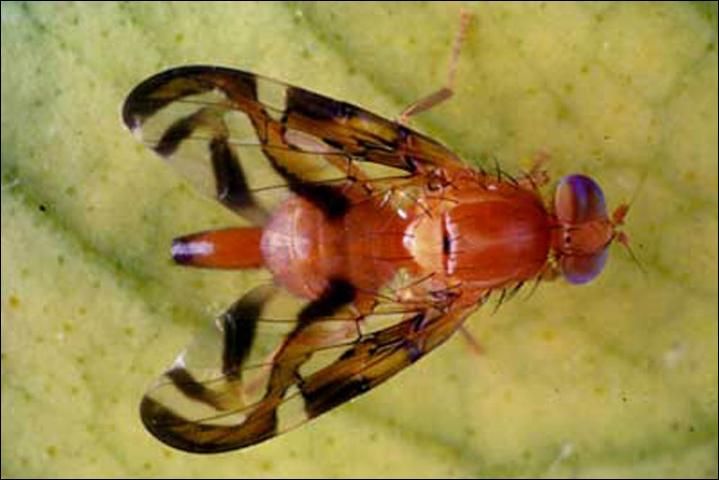
Credit: Division of Plant Industry

Credit: Division of Plant Industry
Larva
The larva is white with the typical fruit fly larval shape (cylindrical, elongated, anterior end usually somewhat recurved ventrally and with mouth hooks, flattened caudal end) but with 10 fusiform areas visible; last instar about 8 to 10 mm (~1/3 to 3/8 in) in length. Anterior buccal carinae normally 8. Cephalo-pharyngeal skeleton with relatively large mouth hook (length 2 X width) with hypostome of nearly equal width; dorsal bridge enlarged; pharyngeal plate longer than dorsal wing plate and with a long pharyngeal support. Anterior spiracles slightly asymmetrical, with a median depression; 12 to 13 tubules present. Caudal end with paired dorsal (D1 & D2) and intermediate (I1 & I2) papillules, plus a distinct I3; prominent L1; indistinct V1 (rarely somewhat prominent); D1 & D2 acutely angled (ca. 45°) and closer together than 11 & 12 (ca. 1/2 distance); I1 & I2 almost in a horizontal line (ca. 10–15°); I1, I3, and L1 approximately in a straight line (at ca. 30°) and I3 twice as distant from I1 as from L1. Posterior spiracles elongated (ca. 3–3.5 X width), with dorsal 2 angled upward and ventral one angled downward on each side of median; most interspiracular processes (hairs) usually not branched distally. Anal lobe always entire. [Described from USNM and FSCA lots from Puerto Rico and Florida.]
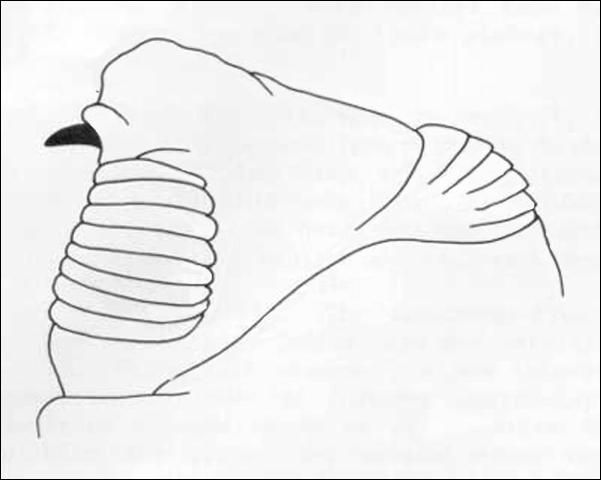
Credit: Division of Plant Industry

Credit: Division of Plant Industry

Credit: Division of Plant Industry

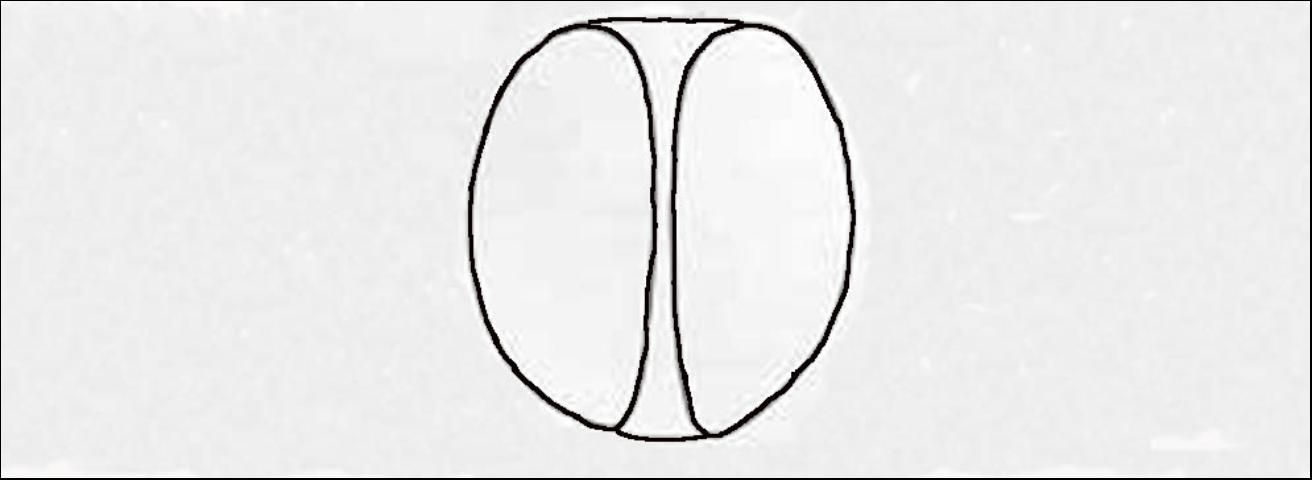
Credit: Division of Plant Industry
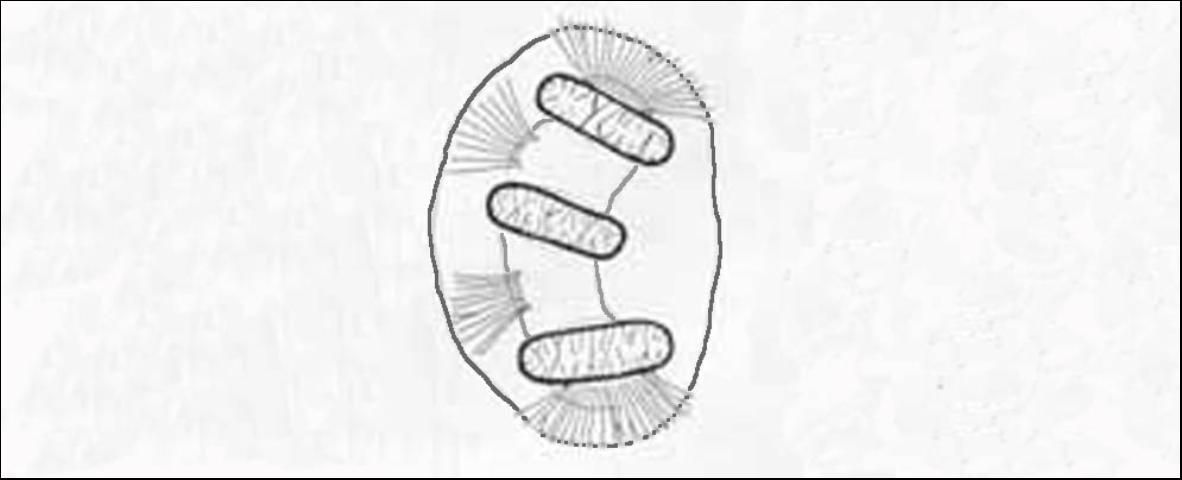
Accurate larval identification of Anastrepha suspensa and other species of Anastrepha is difficult. Mexican fruit fly, Anastrepha ludens (Loew), and Caribbean fruit fly larvae (last instars) may be separated as follows:
- Anal lobes usually bifid (each lobe split); buccal carinae 12 to 14; anterior spiracles usually with 18 tubules (rarely 12 to 18); caudal end with dorsal papillules in each pair as widely separated as in each pair of intermediate papillules (distance between D1 & D2 = I1 & I2), and "lateral" papillules apparently only "single" (papillule I3 not prominent); ventral papillules prominent; posterior spiracles elongated (ca. 1 X 5) and separated medially by approximately 3 X the length of 1 spiracle. . . . . Anastrepha ludens
- Anal lobes always entire; buccal carinae 8; anterior spiracles with 12 to 13 tubules; caudal end with dorsal papillules in each pair distinctly closer together than those of each pair of intermediate papillules (distance between D1 & D2 half that of 11 & 12), and "lateral" papillules with a distinct "pair" of papillules on each side of the posterior spiracles (13 prominent); ventral papillules usually indistinct; posterior spiracles of average length (ca. 1 X 3) and separated medially by approximately 2 X the length of 1 spiracle. . . . . Anastrepha suspensa
The larval descriptions in this publication were made from reared and verified specimens from the U.S. National Museum of Natural History (USNM), Washington, and from other identified lots of larval specimens at the Florida State Collection of Arthropods (FSCA). Nonetheless, these specimens did not result in a configuration of the cephalo-pharyngeal skeleton exactly as published in illustrations of Phillips (1946) and Pruitt (1953). Various populations of each fruit fly species evidently exhibit variations in this and other characters that need to be taken into account. The main characteristics, however, of each species appear to be constant and allow relatively easy identification. The cephalo-pharyngeal skeleton is not usually examined in routine identifications because the larval specimen must be dissected before this character can be examined.
Life Cycle
Anastrepha suspensa infests only mature to overripe fruits. Eggs are laid singly and hatch in about two to three days; the larval feeding period occupies 10 to 14 days, and pupation about the same. Development times are prolonged in cool weather.
Hosts
Nearly 100 hosts have been recorded for Caribbean fruit fly to date, including several Citrus species.
Preferred hosts include:
Eugenia uniflora, Surinam, Brazilian or Cayenne cherry
Prunus persica, peach
Psidium guajava, common guava
Syzygium jambos, roseapple
Terminalia catappa, tropical almond
Field hosts in Florida before 1965: Psidium guajava (common guava)
Caged hosts in Florida before 1965:
Annona cherimoya, Jamaica apple
Carica papaya, papaya
Carissa grandiflora, natal plum
Citrus mitis, calamondin
Eugenia uniflora, Surinam cherry
Fortunella sp., kumquat
Malpighia glabra, Barbados cherry
Mangifera indica, mango
Momordica balsamina, balsamapple
Prunus sp., wild plum
Psidium. cattleianum, Cattley guava
Spondias purpurea, mombin
Greater Antilles field hosts include:
Chrysobalanus icaco, Icaco cocoplum
Chrysophyllum cainito, starapple or cainito
Citrus aurantium, sour orange, C. grandis, pummelo; C. paradisi, grapefruit; C. sinensis, sweet orange
Fortunella margarita, oval or Nagami kumquat
Garcinia sp., garcinia
Malpighia glabra, Barbados cherry
Manilkara zapota, sapodilla
Psidium. cattleianum, Cattley guava; P. guineense, Brazilian guava
Spondias mombin, yellow mombin, jobo or hogplum
Syzygium malaccensis, ohia, Malayapple or mountainapple
It may be significant that the strain of Anastrepha suspensa known to be established in Florida during the 1930s was never found infesting citrus, or any other fruit, on the mainland. In contrast, a strain found in Puerto Rico occurs there in large numbers and attacks a number of tropical and subtropical fruits, including citrus.
Another indication that the Anastrepha suspensa of Puerto Rico has different "tastes" than the Florida strain is indicated by the fact that in Puerto Rico this insect has been found in tropical almonds during every week of the year. At Key West, where there are many tropical almond trees, thousands of almonds were examined over a period of years without finding Anastrepha suspensa. This raises the question as to what assurance there is that the Puerto Rican strain, with "some developed taste" for citrus, if established in Florida, would not become a major pest of citrus in the absence of its preferred hosts.
Damage
Within its normal range of distribution, the economic damage caused by this species has been relatively small, although guavas, roseapples, and Surinam cherries are severely attacked as a rule. Overripe oranges and grapefruit on a few trees in isolated sites in Puerto Rico are damaged in some years sufficiently to be noticeable in late spring, but the species has not been considered a serious pest of citrus in Puerto Rico. In Florida, only very ripe citrus has been attacked. However, a species of insect, or a particular strain of that species, sometimes acts substantially differently when introduced into new areas and may become a serious pest in those new areas. For that reason Anastrepha suspensa is viewed with some concern as a potential pest of commercial citrus, mangoes and peaches in Florida.
Management
Several strategies are currently used by the Florida Department of Agriculture and Consumer Services (FDACS) for the control of Caribbean fruit fly in Florida. The first method involves limited spraying of groves and adjacent areas with pesticide baits. Although pesticide treatments have been shown to reduce fruit fly populations with minimal adverse effects, attempts are being made to develop an integrated pest management approach using biological control techniques.
Biological Control
A solitary endoparasitic braconid wasp, Diachasmimorpha longicaudata (Ashmead), parasitizes larvae of the Caribbean fruit fly and trapping data has indicated a 40 percent reduction in Caribbean fruit fly populations. Diachasmimorpha longicaudata has been produced in Gainesville since 1990 in a joint state/federal mass rearing program. These tiny wasps attack fruit flies by laying eggs in the fly larvae. When the fly is in the pupal stage, the wasp egg hatches and the larva begins feeding on the fly pupa, killing the fly before it can develop into an adult. Although this classical biological control technique is effective in reducing Caribbean fruit fly populations, it is not an eradication technique.
Another biological control method involves the release of large numbers of laboratory-reared sterile flies. This program is known as the Sterile Insect Technique (SIT). Mating between the sterile lab-reared flies and fertile wild flies interrupts the native population because offspring are not produced. SIT also holds promise for effective reduction of the Caribbean fruit fly in Florida. Millions of flies are produced each week at the Caribbean fruit fly mass rearing facility in Gainesville.
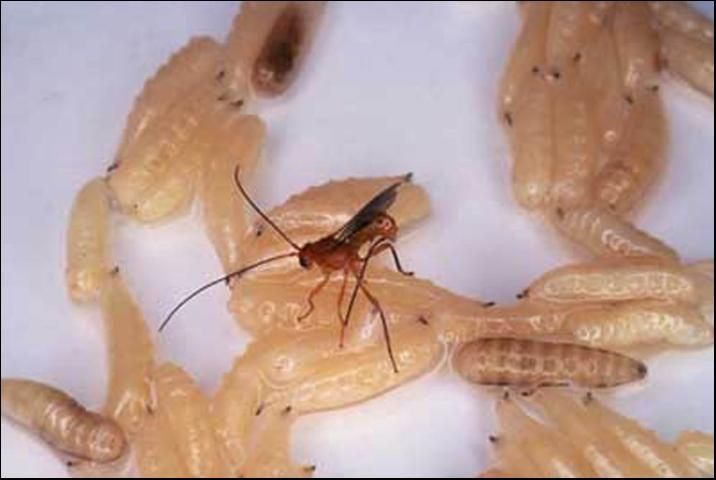
Credit: Division of Plant Industry
Fly-Free Zones
Bermuda, Brazil, China, Columbia, Japan, New Zealand, the Philippines, Thailand, and the United States (the states of California, Hawaii, and Texas) accepted a protocol for the certification of citrus fruit without post-harvest treatment provided the fruit comes from specific Caribbean fruit fly controlled areas ("designated areas").
There are two basic features to this protocol. First, areas must be maintained under certain sanitary conditions, including the removal of preferred hosts from in and around the designated area. Second, trap surveys must be routinely conducted to make sure there are no Caribbean fruit flies in the area.
If certification is based on negative trapping in early season (August 1–December 20), the area must be at least 300 acres and located 1.5 miles (3 miles for shipments to Japan) from residential or other areas containing preferred hosts (common guava, Cattley guava, Surinam cherry, roseapple, and loquat). If certification is based on negative trapping in standard season (December 21—end of harvest season), the area must be at least 300 acres and located three miles from residential or other areas containing preferred hosts. It is the responsibility of the grower/participant to negotiate with the property owner for host removal.
If certification is based on aerial bait sprays, a minimum of 40 acres will qualify as a designated area. There are several methods available for certification under bait-spray provisions: early season: 300 feet from areas containing preferred hosts with bait spray applications; standard season: 300 feet from areas containing preferred hosts with bait spray applications every seven to 10 days for 28 days; and standard season, one-half mile from areas containing preferred hosts with bait-spray applications.
There are other conditions concerning designated areas, buffer zones, control of preferred hosts, trap surveys, certified packinghouses, etc. For details contact your Department of Agriculture. In Florida, contact the Florida Department of Agriculture and Consumer Services—Division of Plant Industry or see its Caribbean Fruit Fly Protocol Program web page.
Selected References
Baranowski RM, Glenn H, Sivinski J. 1993. Biological control of the Caribbean fruit fly (Diptera: Tephritidae). Florida Entomologist 76: 245–251.
Berg GH. 1979. Pictorial key to fruit fly larvae of the family Tephritidae. San Salvador: Organ. Internac. Regional Sanidad. Agropec. 36 pp.
FDACS, Division of Plant Industry. Caribfly control without fumigation. 3 pp.
FDACS, Division of Plant Industry. 1995. Controlling the Caribbean fruit fly in Florida. 4 pp.
Greene CT. 1929. Characters of the larvae and pupae of certain fruit flies. Journal of Agricultural Research 38: 489–504.
Hennessey MK, Baranowski RM, Sharp JL. 1992. Absence of natural infestation of Caribbean fruit fly (Diptera: Tephritidae) from commercial Florida 'Tahiti' lime fruits. Journal of Economic Entomology 85: 1843–1845.
Ibrahim RB. 1980. Fruit flies of Florida (Diptera: Tephritidae). Doctoral dissertation. University of Florida, Gainesville. 355 pp.
Mason LJ, Baronowski RM. 1989. Response of Caribbean fruit fly (Diptera: Tephritidae) to modified McPhail and Jacdson traps: effects of trapping duration and population density. Journal of Economic Entomology 82: 139–1442.
Nation JL. 1990. Biology of pheromone release by male Caribbean fruit flies, Anastrepha suspensa (Diptera: Tephritidae). Journal of Chemical Ecology 16: 553–572.
Peña J, Johnson F. 2000. Insect management in guava. EDIS. https://edis.ifas.ufl.edu/IG072 (26 April 2004).
Phillips VT. 1946. The biology and identification of trypetid larvae (Diptera: Trypetidae). Memoirs of the American Entomological Society 12: 1–161.
Pruitt JH. 1953. Identification of fruit fly larvae frequently intercepted at ports of entry of the United States. Masters thesis. University of Florida, Gainesville. 69 pp.
State Plant Board of Florida Eleventh Biennial Report for the period July 1, 1934-June 30, 1936. 1937. pp. 15–21.
Stone A. 1942. The fruitflies of the genus Anastrepha. U.S. Department of Agriculture Miscellaneous Publication No. 439, Washington, D.C. 112 pp.
White IM, Elson-Harris MM. 1994. Fruit Flies of Economic Significance: Their Identification and Bionomics. CAB International. Oxon, UK. 601 pp.